Pros
Cons
Introduction
Tour
{{section_header}}{{section.name}}{{/section_header}}




Ease of Use
{{section_header}}{{section.name}}{{/section_header}}
Overall, the Exilim EX-H20G is easy to use—certainly as easy to use as any other Exilim cameras. Unfortunately, we still find Casio's interface to be a little confusing. We expect many consumers to wonder the same thing we did: what's the difference between Premium Auto and Auto Best Shot? (As far as we can tell, the former locks you out of all manual controls, while the latter leaves those options open, but doesn't require you to use them.) The choice to shun industry-standard terminology sets Casio apart, but we're not sure this is in a good way.
Even the big selling point of the H20G (it's GPS feature) isn't particularly easy to use. The buttons up top are obvious enough, but using the dpad to navigate among photos on the map isn't exactly intuitive.
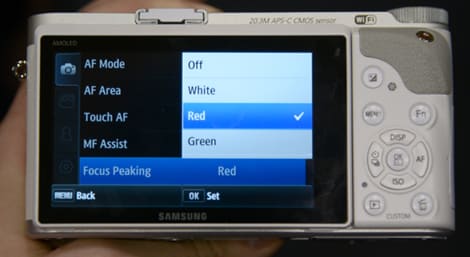
Fortunately, the menu system is very easy to navigate, with options clearly laid out among three tabs. On the other hand, two of those tabs ("REC" and "Quality") have confusing names; it's not exactly clear what options you might find under REC and what options make sense for Quality.
If you're willing to accept the unique nomenclature, the Casio Exilim EX-H20G is quite easy to use, but there is a learning curve you'll have to overcome first.

Size & Handling
{{section_header}}{{section.name}}{{/section_header}}
The Casio Exilim EX-H20G is an average-sized point-and-shoot camera, measuring 4.04 x 2.66 x 1.13 inches and weighing about 7.62 oz. It feels great in the hand, with a nice textured grip on the front and buttons all within easy reach. It's much more comfortable to hold than many ultracompact cameras that are dwarfed by even normal-sized hands.
Our greatest complaint is that the buttons—while all within easy comfortable reach—are difficult to press accurately. The Menu and BS (Best Shot) buttons are especially finicky; they don't give a good tactile response back to the user and it's easy to hit one when you mean to hit the other. The same is true of the playback and camera mode buttons, but to a lesser extent. The dpad, video record button, and GPS buttons are not plagued by this problem.

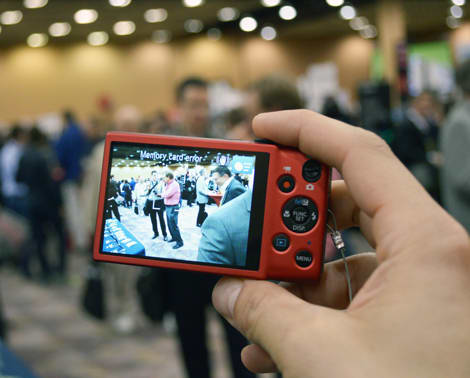
Auto Mode
{{section_header}}{{section.name}}{{/section_header}}
Casio offers two different auto modes on the EX-H20G: "Best Shot" and "Premium Auto." Best Shot has been offered on several previous Casio cameras and, essentially, combines scene modes with intelligent auto or smart auto. If you push the hilariously named BS button, you can choose from an enormous number of scene modes (see Custom Image Presets, below) or you can set BS to auto, which will cause the camera to take a look at the scene you intend to photograph and select a scene mode based on what it sees. You can also select any photo you've taken and add it to the Best Shot menu so that settings will be saved for future use.
"Premium Auto" is also located within the BS menu, with a name that suggests it is somehow superior to the auto mode offered on other cameras. According to the Casio, the H20G uses Premium Auto to analyze scenes pixel by pixel, applying different correction to different portions of the image. In addition to metering for color, exposure, and focus, the H20G also detects whether a face is in the frame, the movement and position of the subject, and whether a tripod is being used. Based on its readings, the camera optimizes for exposure, ISO, sensitivity, focus, blur correction, tonal range, color balance, and noise reduction.
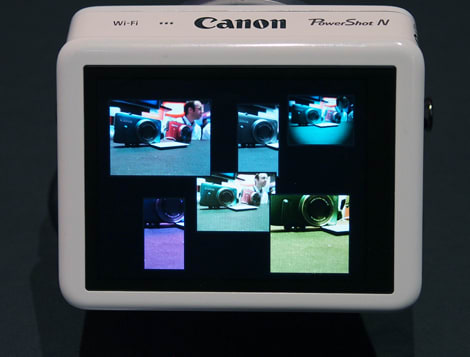
Movie Mode
{{section_header}}{{section.name}}{{/section_header}}
There is no dedicated video mode on the H20G, but there is a separate button for recording video. Push this button and the H20G records 720/30p HD video, encoded in the H.264/AVC format, which makes it easy to drag and drop the resulting MPEG-4 files. In addition to 1280 x 720 recording, the H20G offers standard definition 640 x 480 recording, also at 30fps. The built-in microphone records monaural audio.
Manual controls are generally not available during recording, but you can set things like white balance and some scene modes and the camera will remember these settings when you start to record the video.
Playback Mode
{{section_header}}{{section.name}}{{/section_header}}
While in Playback mode, you can use the zoom toggle to switch between calendar view, thumbnail view, single image, and zoom detail. Thumbnail view shows 25 images at a time, while singe image shows a surprising amount of information, including a histogram.
While in playback mode you can also access Dynamic Photo: a unique (if gimmicky) function that allows the user to use continuous shot to capture several images of a single scene, then remove blurred subjects from a background and combine images onto a different still. It's sort of like Photoshop Jr. built right into your camera. As there is no dedicated continuous shot mode on the camera, you have to select Dynamic Photo from among the Best Shot scene modes in order for this function to work.
Custom Image Presets
{{section_header}}{{section.name}}{{/section_header}}
If you enter Best Shot mode, you will have the option of selecting one of several image presets: Portrait, Scenery, Portrait w/ Scenery, Beach, Snow, Self-Portrait, Two-Person Self-Portrait, Children, Sports, Candlelight Portrait, Party, Pet, Flower, Natural Green, Autumn Leaves, Soft Flowing Water, Splashing Water, Sundown, Night Scene, Night Scene Portrait, Fireworks, Food, Text, and Youtube.
You can also take a picture, then save that photo in a custom Best Shot slot for future use.
Drive/Burst Mode
{{section_header}}{{section.name}}{{/section_header}}
There are no dedicated drive, burst, or bracketing options on the H20G. Dynamic Photo, however, does enact a sort of continuous shot in order to facilitate the use of that option. (See Playback, above.)
The H20G is equipped with a basic self-timer option, which can be set to 10 seconds, 2 seconds, or "Triple Self-Timer" mode. The last takes three photos after a ten-second delay.
Other Modes
{{section_header}}{{section.name}}{{/section_header}}
Panorama Photo Mode
The H20G offers a separate mode for shooting 360-degree photos. It's similar to the stitch assist feature you'll find on many competing cameras.
Manual Controls
{{section_header}}{{section.name}}{{/section_header}}
The Casio Exilim EX-H20G has a surprising number of manual controls, considering its price point and target demographic. Conspicuously missing is any kind of manual aperture or shutter speed control. In its place, however, you have access to manual focus, exposure compensation, ISO, and white balance, plus sharpness, saturation, and contrast. We're not sure who would want this sort of image control without aperture/shutter options.

Focus
{{section_header}}{{section.name}}{{/section_header}}
The H20G does offer manual focus, though it's clear that Casio expects users to rely primarily on autofocus. Contrast detection autofocus includes four different modes: normal autofocus, macro, supermacro, and infinity. You can also select either intelligent AF, spot, multi, or tracking. For low light shooting conditions, there is an autofocus assist lamp. The detection range is approximately 3 inches to infinity, depending on the focus mode.
Manual focus is accomplished using the directional pad and is only effective for subjects at least 6 inches away. While using the manual focus, a distance meter will appear at the bottom of the LCD with positions marked for 15cm, 1m, and infinity. The bar shows your relative position on the meter, but not an exact distance. The center of the screen will zoom in on your subject to aid with obtaining an accurate manual focus.
ISO
{{section_header}}{{section.name}}{{/section_header}}
The Exilim H20G offers a modest select of ISO options, maxing out at 3200. We like to have access to ISO 6400, but if the image is so noisy that it's not even worthwhile, then it's probably for the best that Casio omitted that option. ISO options on the H20G are: Auto, ISO 80, ISO 100, ISO 200, ISO 400, ISO 800, ISO 1600, and ISO 3200.
Aperture & Shutter Speed
{{section_header}}{{section.name}}{{/section_header}}
Aperture is automatically selected from a range of F3.2-F7.5. The H20G also automatically controls shutter speed, selecting from a range of 1 to 1/2000 second. If you enter Night Scene mode, the range of options will expand to 4 seconds. That's a considerably slow shutter speed and is likely to result in blurry images unless the H20G is mounted on a tripod.
White Balance
{{section_header}}{{section.name}}{{/section_header}}
There is an unusual number of options for white balance on the H20G. There is, of course, fully automated white balance, but also several presets that you can select based on your current lighting conditions. These options are: Daylight, Overcast, Shade, Day White Fluorescent, Daylight Fluorescent, and Tungsten. There is also a manual white balance option, which is buried deep within the menus, but is surprisingly easy to use: just push the shutter down halfway and you'll have your manual white balance.
Exposure & Metering
{{section_header}}{{section.name}}{{/section_header}}
Exposure compensation is available in the usual range of +/-2 EV and can be adjusted in 1/3-stop increments. You can choose between multi pattern, center-weighted, and spot metering.
Image Stabilization
{{section_header}}{{section.name}}{{/section_header}}
The H20G employs digital image stabilization using CCD-shift technology. The stabilization is designed to reduce blur caused by hand movement.
Picture Quality & Size Options
{{section_header}}{{section.name}}{{/section_header}}
The H20G records JPEG images with a number of resolution options available. The maximum resolution is 14 megapixels (4320 x 3240), but there are several other resolutions available, including 3:2 and 16:9 aspect ratio options. Two compression options are available: fine and normal.
Picture Effects
{{section_header}}{{section.name}}{{/section_header}}
There are a number of digital effects available on the EX-H20G. The most extensive is Casio's color filters, which digitally add a specific hue to your photos: black and white, brown, red, green, blue, yellow, pink, or purple.
There are also two "cosmetic" effects called Makeup and Landscape Makeup. The former is a common feature in cameras these days: it not only removes blemishes, but creates rosier cheeks. Landscape Makeup is a bit more peculiar. We assume that the name provided by the specs is wrong, since the in-camera option was simply labeled "Landscape." Nonetheless, the option is designed to create "clearer landscape photographs." We've heard of giving people a digital makeover, but landscapes? Maybe the camera will edit out a dead tree from a particularly vain mountainside.
Other Controls
{{section_header}}{{section.name}}{{/section_header}}
Sharpness, Saturation, Contrast
The Exilim EX-H20G gives the user independent control over sharpness, saturation, and contrast—as long as the camera is set to regular auto and not a specific scene mode. These options can be set to one of five increments from -2 to +2.
LCD
{{section_header}}{{section.name}}{{/section_header}}
The Casio Exilim EX-H20G is equipped with an attractive three-inch Super Clear TFT color LCD with a resolution of 460,800 pixels. The screen seems bright and clear, even with lots of bright lights threatening to cast an ugly glare. This will help when you're trying to frame shots, since the H20G—like most point-and-shoot cameras—doesn't have any kind of viewfinder.
LCD brightness can be left to auto or set to one of four manual brightness increments (+2, +1, 0, -1).

Flash
{{section_header}}{{section.name}}{{/section_header}}
The H20G is equipped with a small built-in flash. You have the usual modes to choose from, including Auto, Flash Off, Flash On, and Red-eye Reduction. There's also a Soft Flash option, which is good for filling in shadows in brighter shooting conditions. If you want even more control over the flash output, you can manually select one of five flash intensity increments from -2 to +2.

Lens & Sensor
{{section_header}}{{section.name}}{{/section_header}}
The 24mm wide-angle lens is equipped with 10x optical zoom. The H20G also features Casio's Single Frame SR Zoom, which is similar to other advanced zoom functions in the industry. By taking the un-utilized portions of the sensor during zoom, the camera can achieves 15x zoom without significantly degrading image quality. This extends the camera's 35mm equivalent telephoto focal length to 360mm. The maximum aperture is F3.2.
The sensor is a 1/2.3-inch CCD with a gross pixel count of 14.48 megapixels and an effective pixel count of 14.1 megapixels.
Working in tandem with the lens and sensor, the H20G employs a newly developed processor, called the Exilim Engine HS. Of course, Casio claims that this will allow the camera to capture high quality photos more quickly, but we'll have to reserve judgment on that one until we can get the camera into our labs.

Jacks, Ports & Plugs
{{section_header}}{{section.name}}{{/section_header}}
The H20G is equipped with a proprietary USB/AV port, and miniHDMI output. The AV output can only carry a standard definition signal, but it is compatible with a 50i PAL output for non-American televisions. The miniHDMI output can be used for HDTVs, but is NTSC only.
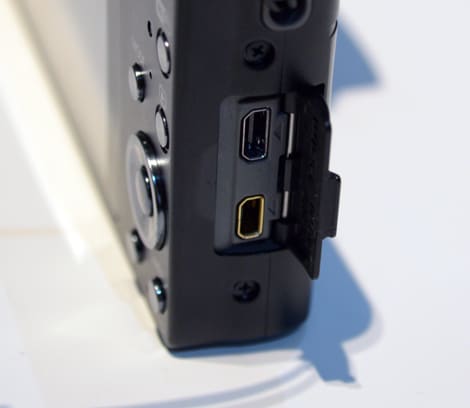
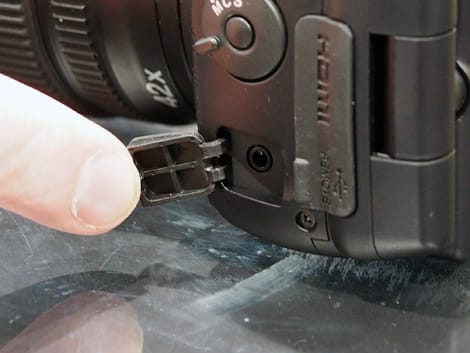
Battery
{{section_header}}{{section.name}}{{/section_header}}
The H20G operates via a rechargeable lithium ion battery (NP-90). Casio claims that the H20G employs a special "advanced low-power technology," designed to consume only small amounts of power, even when the three-way accelerometer and GPS are working.

Memory
{{section_header}}{{section.name}}{{/section_header}}
The H20G records to memory cards and is compatible with SD, SDHC, and SDXC cards.
{{product.manufacturer_specs['FI Memory Photo']}}
Other Hardware
{{section_header}}{{section.name}}{{/section_header}}
Hybrid GPS and Geotagging
The big marketing push for the H20G is its built-in "hybrid" GPS, which Casio claims will offer consumers "ultra-precise location data for the geotagging of photos and videos." It's also the first camera to be able to geotag indoors. The camera has a map feature that will show the user his/her current location, as well as geotagged photos and videos. The geotag data is stored in each photo's EXIF data; compatible photo sharing sites such as Flickr and Picasa will automatically record the location from this data.
What puts the "hybrid" in Hybrid GPS? The H20G combines traditional GPS with inertial navigation, which uses an internal motion sensor to estimate your current position based on the last-known satellite position. That's how the camera is able to do geotagging indoors. (And how many GPS systems in cars keep from getting lost when the satellite position is temporarily lost.) Even when the camera is powered down, the GPS system continues to search for satellite signals at 10-minute intervals.
To make the H20G even more enticing, Casio has preloaded the camera with the locations of 10,000 sightseeing photo spots around the world. The camera automatically alerts you when you're in the vicinity of one of these spots. The H20G also contains detailed maps of 140 world cities (and 12 cities in Japan), so you can plan out your day or get yourself un-lost with the built-in digital compass.
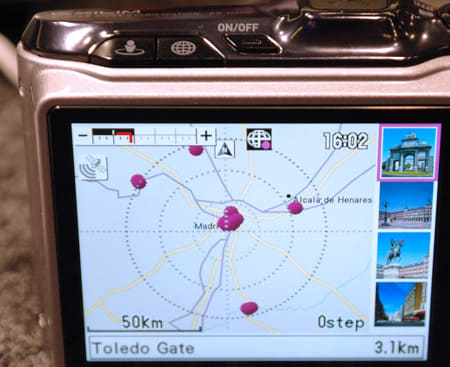
Auto Time Adjustment
A simple feature that "automatically synchronizes the camera's date and time with the user's current location and time zone."
Conclusion
The Casio Exilim EX-H20G is a bit of a conundrum: it's loaded with more "auto" modes than you would ever want and peppered with quite a few manual image adjustments as well. None of this makes for a particularly easy photography experience, but it's not a particularly difficult experience either.
The camera's major selling point, however, is its incredible autonomic GPS, which lets you geotag your photos both indoors and outdoors. The camera is loaded with features to support this aspect of the camera, including saved locations of 10,000 photo spots all over the world. Even we have to admit this is really cool... Photographers that love the geotagging aspect of social media will love the H20G. On the other hand, we find ourselves wishing that Casio had implemented this feature into a better all-around photography experience.
Sample Photos
{{section_header}}{{section.name}}{{/section_header}}
Specs
{{manufacturer_specs_table}}
Meet the tester
Vice President of Editorial Management, Kaitlyn oversees the editorial departments of Reviewed.com’s various sites. She has been writing about technology since the turn of the century. Outside of her Reviewed.com home, Kaitlyn is also a theatre director and avid gamer.
Checking our work.
Our team is here to help you buy the best stuff and love what you own. Our writers, editors, and experts obsess over the products we cover to make sure you're confident and satisfied. Have a different opinion about something we recommend? Email us and we'll compare notes.
Shoot us an email